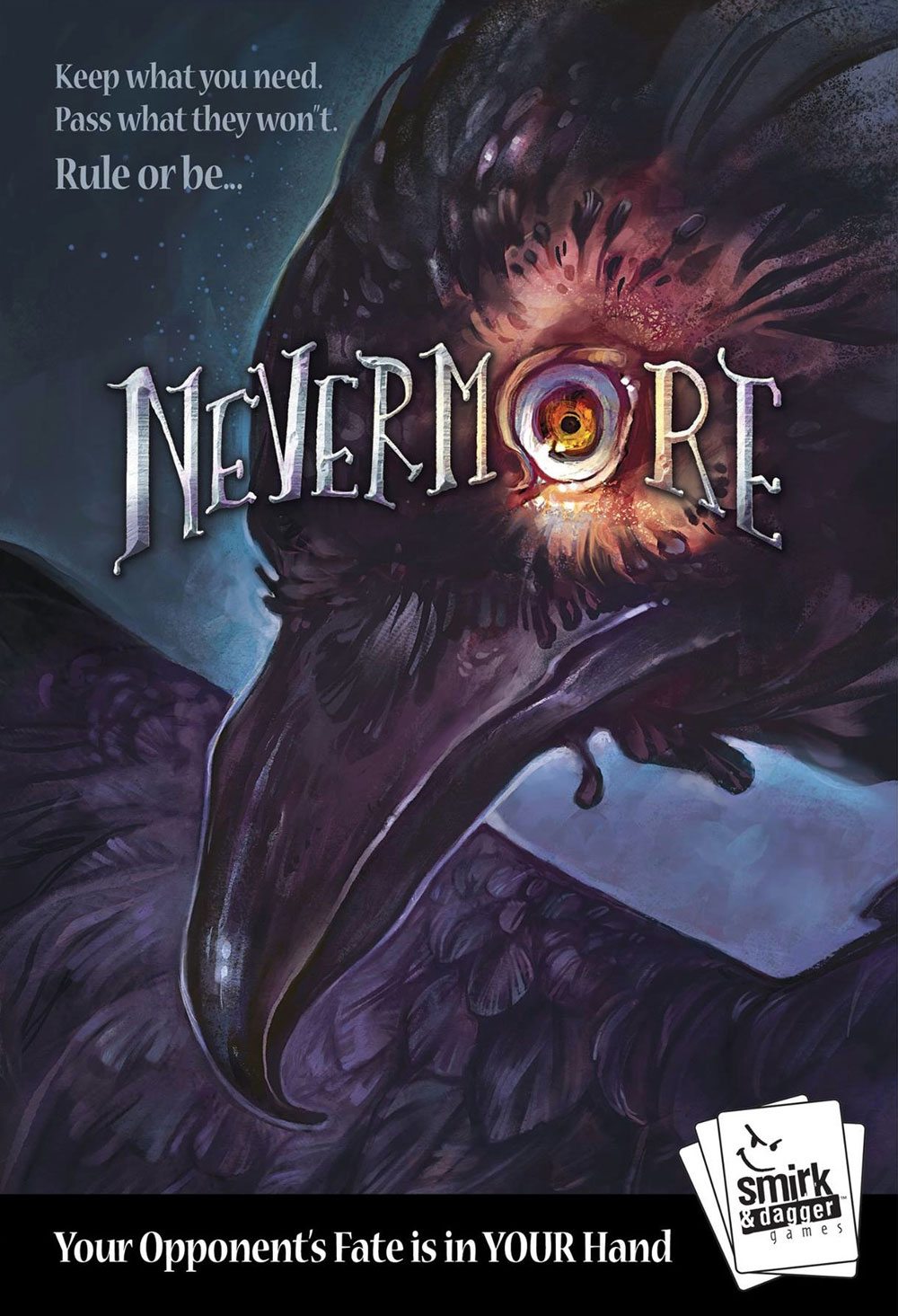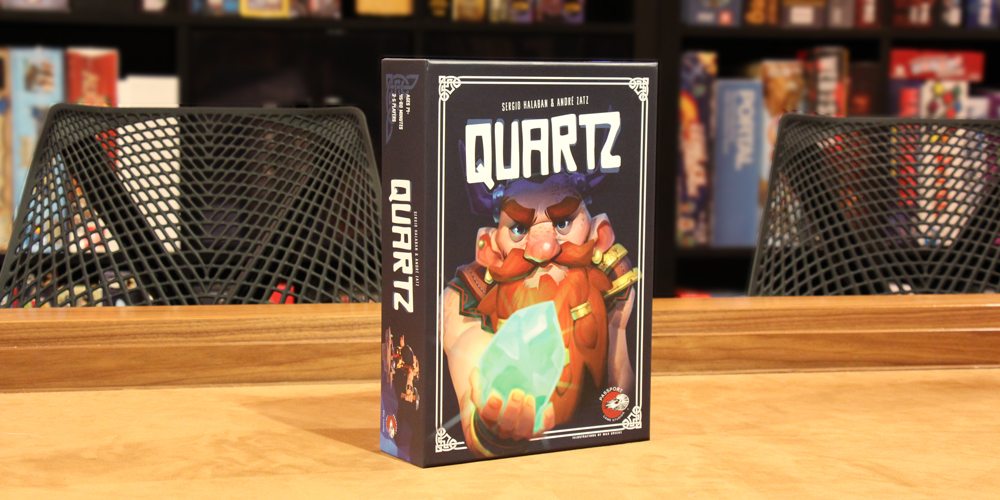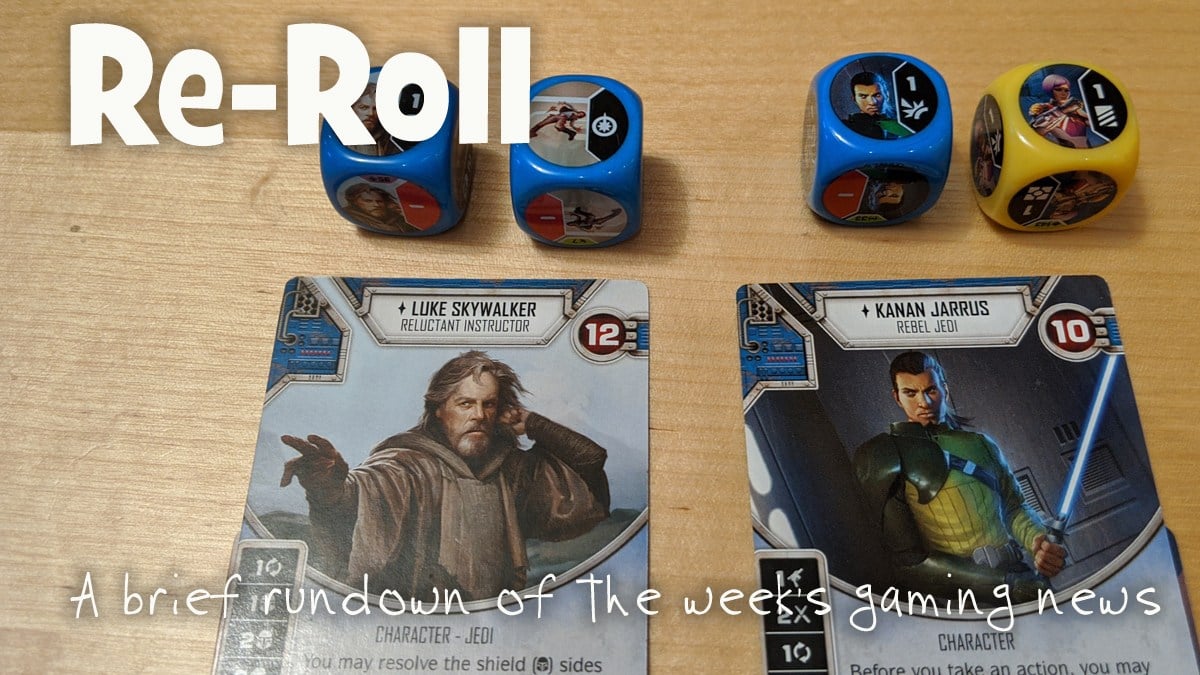There’s an art to drafting–obviously you hope to keep whatever’s best for you, but sometimes it’s worth keeping something just because you know your opponent really needs it. That’s called “hate drafting,” and it really shines in Nevermore.
At a glance: Nevermore is a card-drafting game for 3 to 6 players, ages 14 and up, and takes 45-60 minutes to play. It retails for $29.95. The game could be played by younger players, but note that there is a lot of direct attacking in the game; there is some reading necessary with the spells but they are usually fairly easy to understand.

Components
- 60 Main Deck cards
- 25 Light Magick cards
- 25 Shadow Magick cards
- 6 Player Health tokens
- 30 Health cubes (purple)
- 30 Victory cubes (yellow)
- 1 Direction marker
- 6 Resolution tokens (Conspiracy of Ravens, Attack, Healing, Radiance, Victory, Skulking Ravens)

The cards are a nice quality with a linen finish, and shuffle pretty nicely. The main deck cards have the cover image on the backs, and the fronts just have a single symbol in the center, with a smaller version of the symbol in the corners (like poker cards).
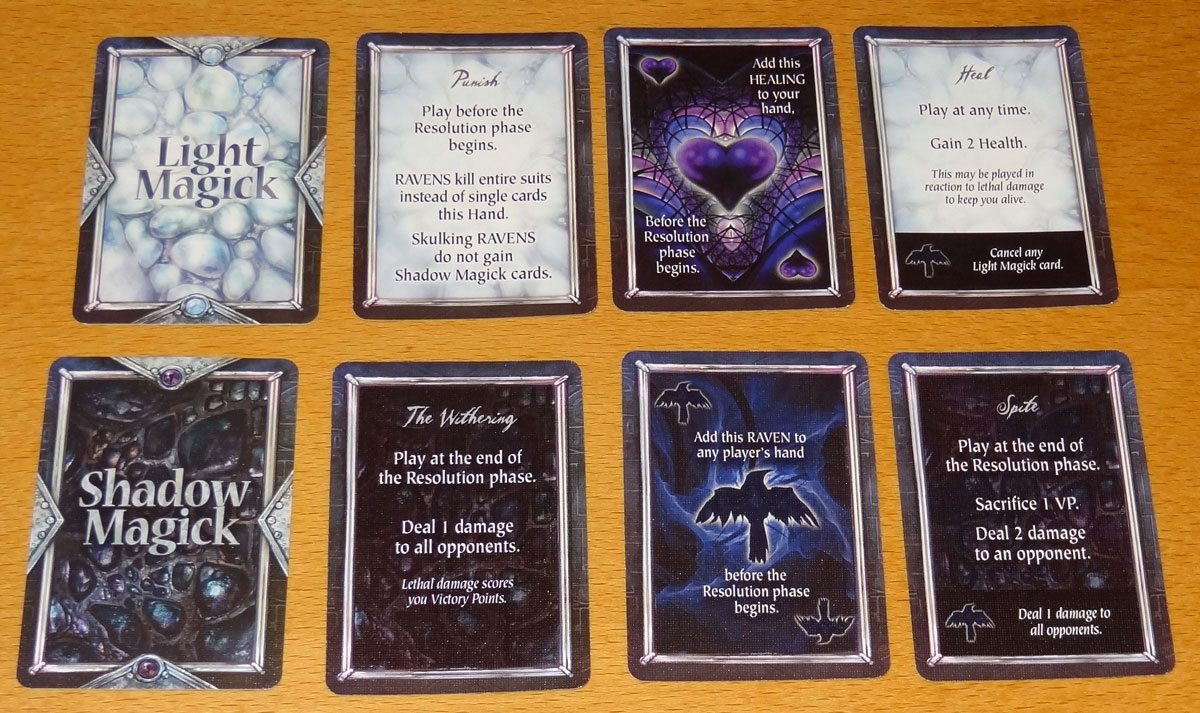
The Light and Shadow Magick cards are mostly text. Each one has a name, explains when you can play it, and its effect. Some Magick cards have a raven icon with some additional text–that’s for players who have turned into ravens.
The resolution tokens and player health tokens are just square cardboard punch-outs, and are fine. They’re easy enough to distinguish from across the table. The direction marker is just a rectangular piece of cardboard that has L or R in a gold circle, along with the game logo, indicating whether to pass the cards left or right.
The box holds everything fairly nicely, though sometimes a few of the main deck cards slip around. It’s medium rectangular box, about the size of a large hardcover book, and is just about the right size for the game. They could’ve cut off one more of the wells for the tokens and it would have been fine, too.
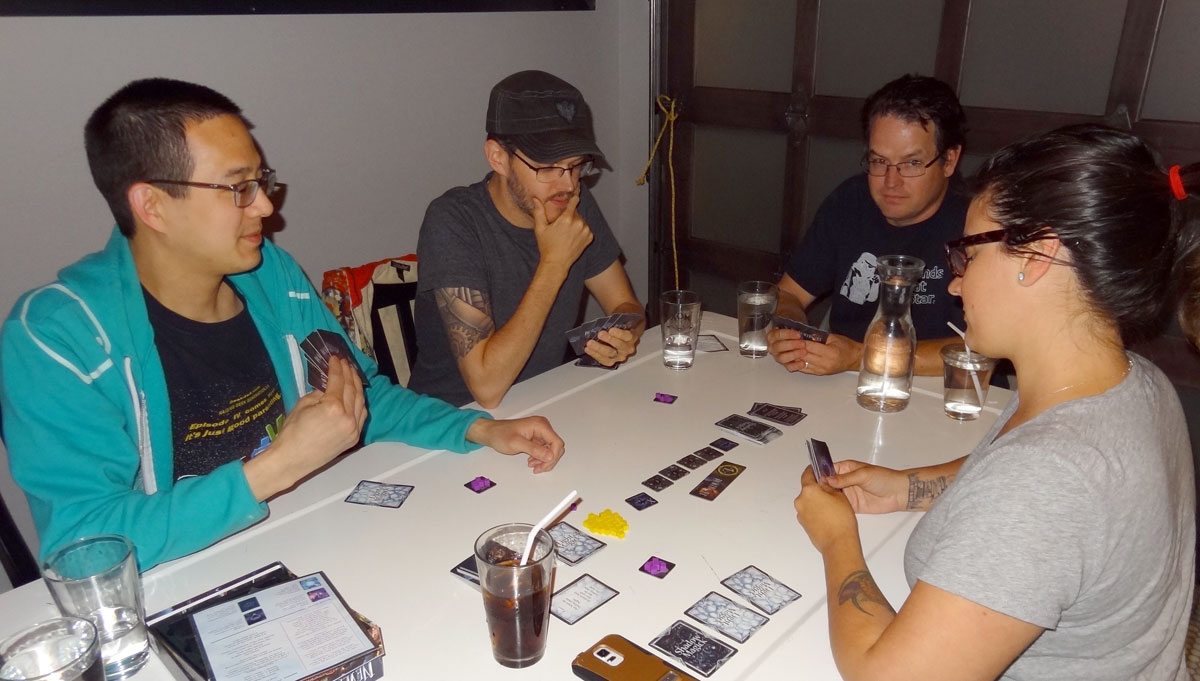
How to play
You can download a PDF of the rulebook here.
The goal of the game is to be the first to 6 victory points (VP), or to be the last surviving human player.
At the beginning of the game, you set up the resolution tokens in the following order: Conspiracy of Ravens, Attack, Healing, Radiance, Victory, Skulking Ravens. In future rounds, you always start with Conspiracy and end with Skulking, but the four in the center will get shuffled randomly. You also start with the “L” side up on the direction token.

Every player is dealt 5 cards from the main deck and 1 Shadow Magick card.
Then there are three turns of drafting. On the first round, you pass three of your five cards, then two, and then one. Note that unlike some drafting games, you may pass any of the cards from your hand, including cards that you kept from previous rounds. Once you’ve finished drafting, you move to the Resolution phase.
The Resolution phase follows the order of the tokens. (On subsequent rounds, you’ll reveal the middle four tokens one at a time as they are resolved.) Each time a suit is called for, you play all the cards you have of that suit. However, Ravens will also kill cards of other suits, so if you have Ravens in your hand, you will pair them up with cards of other suits, and reveal them along with those cards, canceling them out.
For each suit, generally the player with the most of a suit gets to take the action, and the strength of the action is based on the difference between the number they played minus the second-most number played. For example, if the winner had 4 Attack and the second-most had 1 Attack, then the winner gets to attack for 3 damage. If there’s a tie for most, then all players tied for most get the action.
Conspiracy of Ravens: If any player has 5 Ravens in hand, that player does 1 damage to every opponent, draws a Shadow Magick card, and takes 1 VP–and then the Resolution phase ends immediately, and nobody else gets a chance to resolve other suits.
Attack: The winner gets to attack one opponent. Reduce somebody to 0 health? Gain 1 VP. If you manage to attack for 4 or more damage, you may instead attack every opponent for 1 damage, and take 2 VP.
Healing: The winner gets to heal (up to a maximum of 5 health). If you’re at full health and can heal 3 or more points, you instead get 1 VP.
Radiance: The winner draws Light Magick cards. If you play 5 Radiance cards, in addition to getting cards, you’ll also heal 2 points, and get 1 VP.
Victory: The winner gets VP.
Skulking Ravens: If you had 3 or 4 Ravens in your drafted hand, then you’ll have some left over after killing all your other cards–these are called Skulking Ravens. The winner gets to draw Shadow Magick cards.
After the Resolution phase, everyone discards their main deck cards, and a new hand is dealt out. The Direction token is flipped over (to reverse the direction cards are passed), and the four non-Raven resolution tokens are flipped over and shuffled.
The game continues until somebody reaches 6 VP or is only one human player remaining, winning the game.
But wait–there’s more!
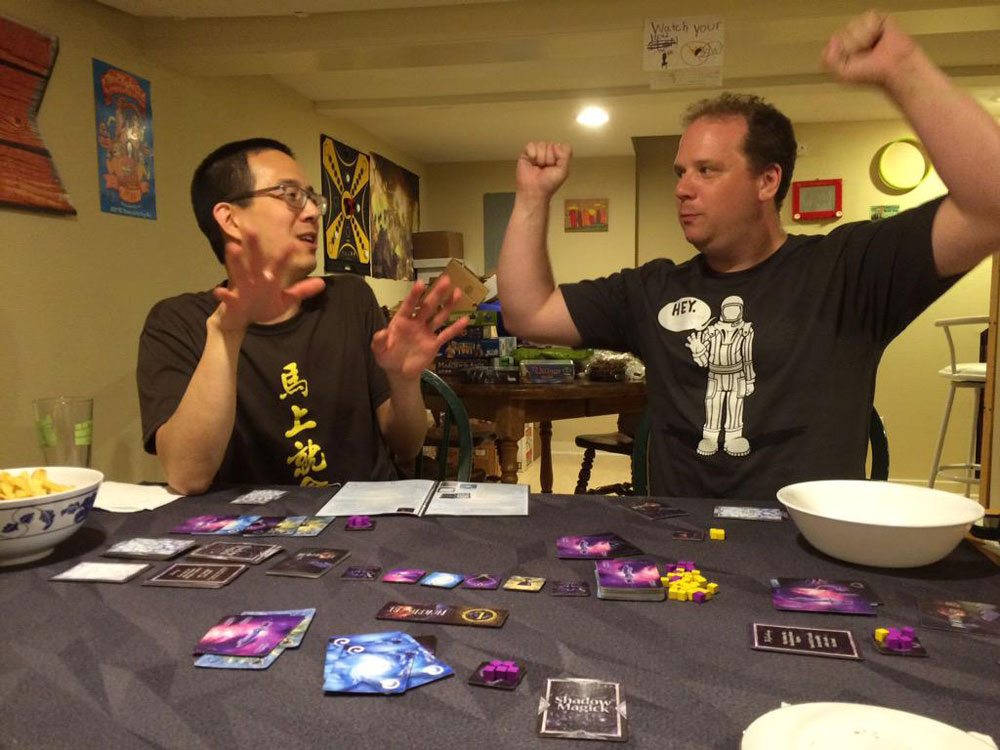
If you run out of health, you turn into a raven. You flip your health token over to show the raven side. You can’t get VP while you’re a raven, and you can’t win, but you can mess with the other players, and try to turn back into a human.
If you can collect either 5 of a kind or 1 of each suit, then you will turn back into a human during the Skulking Ravens portion of the Resolution phase. (Cards that are discarded due to other effects still count toward these conditions.) You get 4 health back, and whatever points you had before you turned into a raven.
While you’re a raven, you still earn Light and Shadow Magick cards as usual, but you no longer resolve Attack, Healing, and Victory as usual. Instead, if you have the most, you get to peck the player who has second-most for 1 point of damage. If you’re the only player with one of those suits, you may peck all opponents or none of them, your choice. Of course, you want to be sure not to peck if it kills all but one human player, because that would let somebody else win. But if you manage to kill off all the other humans while you’re a raven, you turn back into a human and win the game.

The Verdict
Drafting is a mechanic that is sometimes used to balance out the luck of the draw–a person with a “bad” hand gets to spread those cards around, and a person with a “good” hand must do the same. In addition, passing cards gives you a little bit of knowledge about the pool of cards among all the players, and also some degree of control over your final hand. In some games (like Food Fight), drafting is used as part of setup or after a deal; in others (like 7 Wonders or Sushi Go) it is the primary mechanic of the game.
Nevermore uses drafting as the primary mechanic, but each suit has its own abilities–so instead of just one “best hand,” there are actually five “best hands,” one for each suit. While you’re trying to collect all the Radiance cards so you can get a bunch of Light Magick cards, maybe you’re also passing all the Attack cards to your neighbor … allowing her to damage you.
The Ravens are particularly interesting–they seem like bad cards, because they kill off other cards in your hand, making them useless. But if your neighbor keeps passing you Ravens (and you decided to keep them), you could gain a lot of the more-powerful Shadow Magick cards. Or, better yet, collect 5 Ravens and you shut everyone down, damaging them and collecting points. That’ll teach them to keep passing their Ravens to you!
The game is fairly easy to teach, although it would be nice to have summary cards for all the suit effects. Fortunately there’s a handy reference on the back page of the rulebook for the special hands, but a reference card for each player would have been a nice touch.
Of course, it wouldn’t be a Smirk & Dagger game if it didn’t have a good helping of back-stabbing, and that’s where the Magick cards come in. There are some cards that just go into your hand as extra cards of a particular suit. Others let you exchange hands with another player, or gain healing. There are even cards that let you snatch victory from a player, though they can backfire on you if you guess wrong.
The Raven player idea is also pretty fun. It doesn’t happen in every game–I’ve played a few times where somebody won before anyone lost all their health–but when it does, it changes the game’s dynamics. Raven players can’t win, but they also aren’t concerned about health anymore, so Attack cards can’t hurt them and Healing cards don’t help them. Instead, anything they collect most of just prevents other players from getting their actions, and lets the Raven players do damage or collect more Magick cards. Some players (the ones who are always excited to be the hidden traitor) may even prefer being Ravens, hoping to get attacked early so they can start interfering with everyone’s plans.
I’ve played with different player counts, and I do prefer Nevermore with more players, simply because there are a lot more cards on the table and things can get more chaotic. With at least 4 players, you know that none of the cards you pass will come back to you. With 3 players, it’s possible that you’ll get one of those cards back. So that can have an effect on what you pass, and how well you can plan for the future. More players also means a higher chance of ties for winning each suit–that means multiple players will get the effect of the suit. More attacks, more Magick cards … it can get pretty crazy.
But whether you’ve got 3 or 6, Nevermore is a blast to play and chances are you’ll start up another round as soon as you’re done. It’s a medium-weight game, so if you’re looking for something really deep this may serve more as filler, but for casual gamers I could see this being a good main event.
Nevermore is in stores now, or available from Amazon.
Disclosure: I received a review copy of this game.

